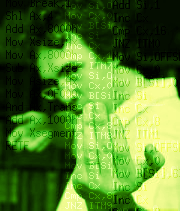| Nah, not precisely that device, but quite close. |
 |
| And not quite that SoC, but an OMAP anyway... |
| Nah, not precisely that device, but quite close. |
 |
| And not quite that SoC, but an OMAP anyway... |
Tags: hardware
Le portail Wifi qui nous connectait au monde de Bilou s'est effondré. Les forces de l'empire Télétravail ont fait intrusion, entendant stabiliser leur hyper-tunnel privé sécurisé contre les fluctuations de l'étoile 192.168.0.24. Résultat, tout le système stellaire a été basculé en WPA alors que l'astro-cruiser ne peut communiquer qu'en WEP.
J'avais envoyé sur place ma sonde ZD1201 qui m'avait déjà tiré d'affaire quelques fois, mais si la DS peut bien voir le nouveau réseau, par contre, je n'ai pas encore réussi à m'y connecter. Echec à la première tentative. Freeze de la DS à la seconde (dans runMe). Serait-ce lié au fait que je n'ai pas su définir de clé WEP pour le nouveau réseau ?Je n'ai plus le concierge-Mario Kart, mais j'ai un menu de configuration wifi dans Phantom Hourglass ... qui ne fait guère mieux. Le pilote est maintenant maintenu par les gens du Noyau et son firmware est pré-distribué par la Fédération Ubuntu.
Wireshark restait muet. Ce n'est pas surprenant: si les paramètres de chiffrement sont incorrects, le stick wifi ne reconnaîtra pas les ondes comme étant un paquet pour lui et ne passera rien à la pile réseau Linux.
Mais ça c'était hier. Je viens de refaire un essai avec la tablette de ma fée d'abord, puis à nouveau avec Phantom Hourglass et je vois enfin des requêtes DHCP dans wireshark. Dont une avec une adresse MAC de chez Nintendo. Tout espoir n'est donc pas perdu.
Par contre, le logiciel que j'avais utilisé à l'époque pour le DHCP n'est plus distribué par Ubuntu qui lui a préféré UDHCPD, l'implémentation interne à BusyBox (dont il faudra que je vous reparle). Donc,
# The interface that udhcpd will use
interface enx00cafe00babe # default: eth0
devrait me permettre d'être serveur DHCP sur le stick wifi (à l'adresse MAC improbable 00:ca:fe:00:ba:be) tout en restant client sur les autres.
J'avais tenté d'utiliser une adresse statique hier, évidemment, mais sans succès. Au moindre test de connexion, le logiciel WFC sur la DS me lâchait juste un "paramètres incorrects". En réalité, si on désactive les requêtes DHCP sur la DS, il faut impérativement fournir *tous* les paramètres, y compris la passerelle à utiliser, le DNS, etc. j'ai probablement été un peu négligent là-dessus.
Affaire à suivre. Pourvu que nos héros tiennent bon.
Quand j'aurai pu vérifier que ça fonctionne, il me restera à créer une liste de règles iptables propres aux échanges avec les Nintendo DS (disons DSIN), y rediriger le traffic entrant venant d'une adresse MAC de NDS (/sbin/iptables -A INPUT -m mac --mac-source 00:0F:EA:91:04:08 -j DSIN) et jeter tout le reste qui vient de l'interface supplémentaire-et-non-protégée. (/sbin/iptables -A INPUT -i enx00cafe00babe -j DROP)
Tags: wifi
Bon, ça fait quelques semaines, maintenant que j'ai fini Breath of the Wild, et je dois bien dire que c'était un très bon jeu. Ça au moins, ça ne fait pas de doute. Par contre, est-ce vraiment un Zelda ? Les personnages sont là, c'est indéniables, mais la série Zelda, c'est un gameplay en plus d'un univers. La série a commencé avec un gameplay "sauce soja" avec des ennemis qui mettent l'accent sur la mobilité et des donjons à clés.
Occarina of Time a lancé un deuxième type de gameplay "au ketchup" avec des ennemis qui mettent l'accent sur la visée et des donjons tordus dans tous les sens. Mais que l'on soit dans l'un ou l'autre il y a un nombre significatif de mécaniques de jeu qui sont restées inchangées. Les petits coeurs dans les buissons ou les clés-du-boss. Les items qui servent à la fois d'arme et de moyen de transport, et qui doivent être acquis à la sueur de nos neurones dans les donjons.Breath of the Wild donne un gros coup de pied dans tout ça. Tous les objets spéciaux sont concentrés dans le prélude (équivalent de la période "trois talismans" pour les habitués de LttP ou OoT). Des armes à durée limitée et un stock de plats cuisinés à partir d'objets ramassés pendant la quête qu'on peut manger même au milieu d'un combat de boss. J'ai commencé par penser qu'on était sur une troisième sauce (disons "moutarde l'ancienne"), mais à voir un peu la diversité de la licence à l'occasion du Zeldathon, en particulier les "Hyrule Warriors", je me dis que Breath of the Wild est peut-être plus proche d'un nouveau plat que d'une nouvelle sauce.
Un montage graphique pour me rappeler de ce que j'ai à corriger, ça n'avait pas trop mal marché quand j'avais démarré la School Zone. Je me dis que ça pourrait marcher aussi pour mon challenge des "trois téléporteurs" ... Tentons, donc.
Tags: dr21, dreamland, ThreeRooms, todo

 somewhere, on planet Earth, there's a weird guy named Sylvain (aka. PypeBros) who loves to write programs and draw comics with a blue ball named "bilou". That's me.
If you have a blog that talks about similar stuff, just leave me a comment.
somewhere, on planet Earth, there's a weird guy named Sylvain (aka. PypeBros) who loves to write programs and draw comics with a blue ball named "bilou". That's me.
If you have a blog that talks about similar stuff, just leave me a comment.